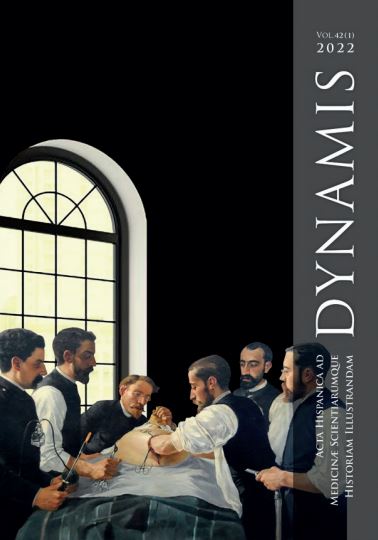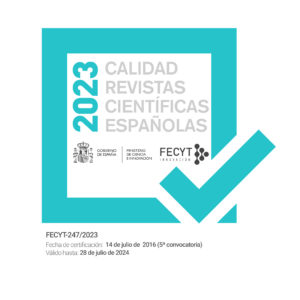New data for the history of opium in Islamic medicine: Barš in the Resāla-ye afyūn of ͨ Emād-al-Dīn Maḥmūd Šīrāzī, Iranian physician of the 16th century
DOI:
https://doi.org/10.30827/dynamis.v42i1.26893Keywords:
Islamic medicine, opium, barš, ᶜEmād-al-Dīn Maḥmūd Šīrāzī, Resāla-ye afyūnAbstract
This article describes the main investigations published to date on the history of the therapeutic and recreational use of opium in classic Islam bet- ween the 7th and 17th centuries. It presents the historical figure of Iranian physi- cian ᶜEmād-al-Dīn Maḥmūd Šīrāzī (1515-1592) and describes the general content of his Resāla-ye afyūn [Treaty on opium], the main monographic treaty that has reached us on the medicinal uses of opium in Islamic civilization. More specifi- cally, this study addresses the history of barš, the opiate most widely used as a medicine and recreational drug by Islamic populations between the 12th and 19th centuries, describing its composition, the origin and meaning of its name, and the sources on barš cited by ᶜEmād-al-Dīn. It also outlines the transmission of knowledge on this opiate from Galen to Arab authors of the 12th and 13th centuries and from these to the medicine of Safavid Iran in the 16th century, analyzing its history in Arab and Iranian medical circles of the 12th-16th centu- ries. It is concluded that Resāla-ye afyūn represented a significant advance in the medicinal uses of barš with respect to the knowledge of Arab physicians.
Downloads
References
Al-Anṭākī. Taḏkirat ūlī al-albāb wa-l-ŷāmic li-l-c aŷab al-c uŷāb. Bayrūt: al-Maktaba al-Ṯaqāfiyya, s.a.
Al-Muh. ibbī. Julāṣat al-aṯar f ī ac yān al-qarn al-h. ādiya c ašara. Bayrūt: Dār al-Ṣādir, s.a.
Alpino, Prospero. La Médicine des Egyptiens, trad. R. de Fenoyl. Le Caire: Institut Français d’Archéologie Orientale du Caire, 1980.
Al-Zabīdī. Tāŷ al-c arūs. Al-Qāhira: al-Maṭbac a al-Jayriyyaa, 1306 H.
Anawati, G. C. “Fakhr al-Dīn al-Rāzī.” In The Encyclopaedia of Islam. New Edition, edited by B. Lewis, Ch. Pellat, and J. Schacht, II, 751-755. Leiden: E. J. Brill, 1991. c
Awwād, Mijā’īl, and c Awwād, Kūrkīs. Al-Rasā’il al-mutabādala bayna al-Karmalī wa-Taymūr. Bagdād: Dār al-Ḥurriyya li-l-Ṭibāc , 1974.
Aynur, Hatice, and Schmidt, Jan. “A debate between opium, berş, hashish, boza, wine and coffee; the use and perception of pleasurable substances among Ottomans.”
TUBA 31, no. 1 (2007): 51-117.
Ayyūb, ᶜAbd al-Rah. mān, and Ṭāhir, Muṣṭafà Anwār. “Traité de la Subjugation des Enjoliveurs sur le Blâme des Drogués. Qamc al-wâshîn f î dhamm al-barrâshîn d’abû-lh. assan ᶜalî ibn al-djazzâr.” Cahiers d’Études Arabes et Islamiques 4 (1977): 52-70.
Bari, Abdul, and Hussain, Arshad. “Hakim al-Din Mahmud Shirazi and Risalah Bikh-i Chini.” Studies in History of Medicine and Science 17, no. 1-2 (2001): 73-85.
Bhargava, Meena. “Narcotics and Drugs: Pleasure, Intoxication or Simply TherapeuticNorth India, Sixteenth-Seventeenth Centuries.” The Medieval History Journal 15, no. 1 (2012): 103-135.
Burton, Richard F. A plain and literal translation of the Arabian nights´ entertainments, now entitled The book of the Thousand Nights and a Night. Benares-London, 1885.
Cooke, Mordecai Cubitt. The Seven Sisters of Sleep. London: James Blackwood, 1860 (reimp. Lincoln, Massachusetts: Quarterman Publications, Inc., 1989).
Delgado-García, Guillermo, Rodríguez-Návarez, Carolina, and Estañol, Bruno. “Sobre el filonio romano.” Gaceta médica de México 152 (2016): 838-842.
Dozy, Reinhart. Supplément aux dictionnaires arabes. Leiden, 1881 (reimp. Beirut: Librairie du Liban, 1981).
Elgood, Cyril. Safavid Medical Practice, or The Practice of Medicine, Surgery and Gynaecology in Persia between 1500 AD and 1750 AD. London: Luzac, 1970.
Elgood, Cyril. A Medical History of Persia and the Eastern Caliphate. Amsterdam: APAAcademic Publishers, 1979.
ᶜEmād-al-Dīn Mah.mūd Šīrāzī. Resaleh Afiounieh, edited by R. Choupani, O. Sadeghpour, and V. Panahi. Tehran: Al-Maᶜa, 2009.
Ergin, Nina. “Rock faces, Opium and Wine: Speculations on the Original Viewing Context of Persianate Manuscripts.” Der Islam 90, no. 1 (2013): 65-105.
Gesenius, H. F. Wilhelm et al. A Hebrew and English lexicon of the Old Testament, with an appendix, containing the Biblical Aramaic. Oxford: Clarendon Press, 1906.
Golshani, Seyyed Alireza et al. “Hakim Imad al-Din Mahmud ibn-Masc ud Shirazi (1515-1592 A.D.), a Physician and Social Pathologist of Safavid Era.” Galen Medical Journal 2, no. 4 (2013): 169-173.
Heydari, Mojtaba, Hashempur, Mohammad Hashem, and Zargaran, Arman. “Medicinal aspects of opium as described in Avicenna’s Canon of Medicine.” Acta Medico Historica Adriatica 11, no. 1 (2013): 101-112.
Honchell, Stephanie. Pursuing pleasure, attaining oblivion: the roles and uses of intoxicants at the Mughal court. University of Louisville, 2010.
Ibn Hubal. Kitāb al-Mujtārāt f ī l-ṭibb, edited by Fuad Sezgin. Frankfurt: Mac had Ta’rīj al-c Ulūm al-c Arabiyya wa-l-Islāmiyya f ī iṭār Ŷāmic at Frankfurt, 1417/1996.
Ibn Manẓūr. Lisān al-c arab. Bayrūt: Dār Ṣādir, s.a.
Ibn Sīnā. Al-Qānūn f ī l-ṭibb, edited by Idwār al-Qašš. Bayrūt: c Izz al-Dīn li-l-Ṭibac a wa-l-Našr, 1408/1987.
Kermani, Kohi. History of opium and opium addicts in Iran [en farsi]. Tehran: Elmi Publication, 1945.
Kiani, H., Nimrouzi, M., and Parsaei, M. “Introduction of an Outstanding Scientist of Iranian and Islamic Traditional Medicine: Emadodin Mahmoud-Ibn Masoud Shirazi.” Journal of Islamic and Iranian Traditional Medicine 2, no. 3 (2011): 251-252 [en farsi].
Kohlberg, E. “Bahā’-al-Dīn ᶜĀmelī.” In Encyclopaedia Iranica, edited by Ehsan Yarshater, III, 4, 429-430. Costa Mesa, California: Mazda Publishers, 1988.
Kūhīn al-ᶜAṭṭār. Minhāŷ al-dukkān wa-dustūr al-ac yān. Al-Qāhira: Maktabat al-Ŷumhūriyya al-c Arabiyya, s.a.
Lane, Edward William. An Account of the Manners and Customs of the Modern Egyptians. The Hague and London: East-West Publications; Cairo: Livres de France, 1895
(reimp. East-West Publications, 1989).
Lozano Cámara, Indalecio. Tres tratados árabes sobre el cannabis indica. Textos para la historia del hachís en las sociedades islámicas (s. XIII-XVI). Madrid: AECI, 1990.
Lozano Cámara, Indalecio. “Elementos para una historia del opio en la medicina árabe (siglos VII-XVII).” In Huellas inéditas del VI Congreso Internacional de Etnobotánica. Recovered Tracks from the VIth International Congress of Ethnobotany (ICEB 2014), edited by F. Herrera Molina, J. A. Hurrel, F. Tarifa García, and J. E. Hernández Bermejo, 195-205. Córdoba: UCOPress, 2017.
Lozano Cámara, Indalecio. “Historia social y científica de la adormidera y el opio en el islam clásico: fuentes primarias y propuesta de investigación.” Panace@. Revista
de Medicina, Lenguaje y Traducción 20, no. 50 (2019): 77-87.
Matthee, Rudi. The Pursuit of Pleasure: Drugs and Stimulants in Iranian History, 1500-1900. Washington: Mage Publishers, 2005.
Newman, A. J. “Ṣafawids.” In The Encyclopaedia of Islam. New Edition, edited by C. E. Bosworth et al., VIII, 777-787. Leiden: E. J. Brill, 1995.
Pines, S. “Abū l-Barakāt.” In The Encyclopaedia of Islam. New Edition, edited by H. A. R. Gibb et al., I, 111-113. Leiden: E. J. Brill, 1986.
Rosenthal, Franz. The Herb. Hashish versus Medieval Muslim Society. Leiden: E. J. Brill, 1971.
Rosenthal, Franz. “Ḥamza al-Iṣfahānī.” In The Encyclopaedia of Islam. New Edition, edited by B. Lewis et al., III, 156. Leiden: E. J. Brill, 1986.
Russell, Alex M. D. The Natural History of Aleppo. London, 1794.
Savage-Smith, Emilie. “Emād-al-Dīn Mah.mūd.” In Encyclopaedia Iranica, edited by Ehsan Yarshater, VIII, 381-382. Costa Mesa, California: Mazda Publishers, 1998.
Steingass, F. A Comprehensive Persian-English Dictionary. London-Henley-Boston: Routledge & Kegan Paul, 1892 (reimp. 1977).
Storey, C. A. Persian Literature: A Bio-Bibliographical Survey. London: Royal Asiatic Society, 1971.
Tibi, Selma. The medicinal use of opium in ninth-century Baghdad. Leiden-Boston: Brill, 2006.
Vogt, E. Lexicon linguae aramaicae veteris testament. Roma: Pontificium Institutum Biblicum, 1971.
Zillurrahman, S. “Ḥakīm ᶜImāduddīn Shīrāzī.” Sudies in History of Medicine and Science 9 (1985): 15-21.
Downloads
Published
How to Cite
Issue
Section
License
Dynamis se encuentra adherida a una licencia Creative Commons Reconocimiento (by), la cual permite cualquier explotación de la obra, incluyendo una finalidad comercial, así como la creación de obras derivadas, la distribución de las cuales también está permitida sin ninguna restricción.

















